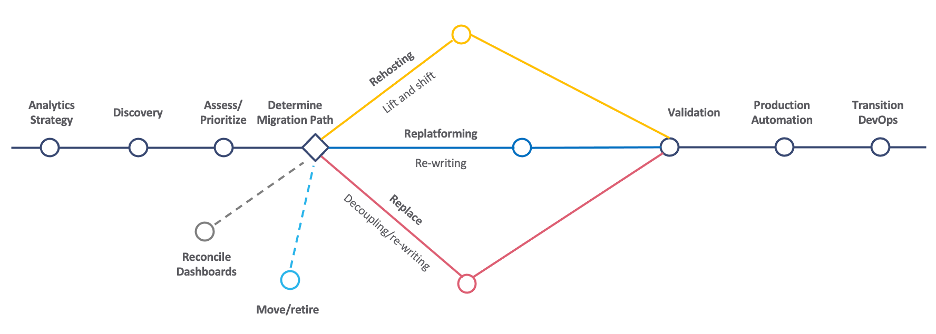
By Anshuman Swain, Sr. Director of Data & Analytics
Many organizations are still using antiquated software or hardware. While these systems may still meet the requirements they were originally designed for, they are typically based on old technologies that are no longer common. The incompatibility with new technologies can bring technical debt.
Migrating from one business intelligence (BI) tool to another requires well-thought-out design, removal of waste and redundancies, the advantages provided by automation, and experienced execution to eliminate project risks and reduce costs.
Strategies to Accelerate Migration & Reduce Risk
There are three types of BI system migration: rehost, replatform, and replace.
A Rehosting migration is a means of migrating an application and its associated assets to a new infrastructure (cloud/modern) as-is. Lift-and-shift of the application requires focusing on the configuration to achieve the end goal.

A Replatforming migration is a means of moving applications to the cloud/modern platform without major changes but taking advantage of the benefits of the modern technology environment. This migration process requires some level of code re-writing.
A Replacing migration is a means of retiring the application and replacing it with a new cloud-native /modern application. This migration process is a bit complex and demands more planning, however, is more scalable, resilient, and provides a long-term cost-benefit.
Key Considerations for Report Migration:
- Report Catalog: Report metadata catalog provides a great opportunity to understand the usage of reports, scope to merge multiple reports into one, and eliminate redundancies. The catalog also helps to understand how the BI platform is used and provides the opportunity for adoption and scale-up.
- Reconcile and Reduce: Understand usage, eliminate redundant reports, build a lean platform, and enable governance for the analytics platform.
- Accelerators: Leverage Software-as-a-Service (SaaS) products to accelerate migration and ensure quality is maintained.
- Analytics at Scale: Design the solution architecture considering analytics usage cases, adoption, and business growth. Map out the solution to your future state.
- Project Team: Identify stakeholders and executive support, onboard the right technical team, and build a governance model to support the project execution.
- Implement a Training Program: Train end-users, developers, and admins for maximum adoption and success.
Gartner notes six common mistakes that cause migration costs to go off the rails:
- Wrong Team
- Wrong Emphasis
- Mistimed Work Effort
- Rushed Tool/App Assessment
- Poor Future Sate Architecture
- Hidden Costs
Migrating to a modern business intelligence tool doesn’t need to be difficult. Selecting the right platform and migration approach can help your organization realize the value of its data quickly, and efficiently.
Paradigm Technology’s Report Migration team accelerates the migration process, helping organizations by enabling self-service analytics, building a single source of truth, streamlining BI tools across the organization, and eliminating technical debt. Our synergistic services are easy and intuitive, enabling engagement and teamwork.
For more information and to see how Paradigm can help you in your Digital Intelligence journey, get in touch with one of our Data & Analytics experts today.

